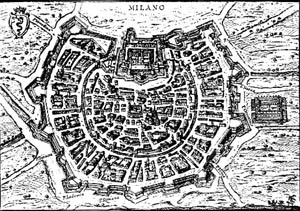 |
|||
 |
|||
|
The
plan of Milan, as well as the plan of other towns on the plain,
is a circle approximately: the concentric rings that surround a
central core are evident and testify the progressive increase of
the town over the centuries. One of the possible interpretations
of this shape is the isoperimetric property of the circle: the circle,
among all the plane figures with a given perimeter, is the one which
contains the largest area, or in a comparable way, among the plane
figures with a given area, is the one with the shortest perimeter.
The two problems are in fact equivalent. In the first exhibit it is possible to test this property: if you give an arbitrary shape to a flexible ribbon and you fill it with little balls, you can see that it takes a circular shape. Now,
let's consider rectangles only, instead of taking into account,
as above, all the figures of the plane: what is the solution of
the problem "maximum area at constant perimeter"? One can find an
experimental answer thanks to some closed little strings of a given
length, that it is possible to stretch across a
chessboard : here is the proposal of another table of tests.
In the third exhibit, one can try to find the solution of the "symmetric"
version of the problem thanks to equilateral
triangle shaped tesserae: which is the figure with the shortest
perimeter among all those having a given area? Let's replace plane figures with tridimensional objects: the terms of the isoperimetric problem can be redefined by demanding what is the kind of tridimensional figure that, volume being equivalent, has the minimum exterior surface, or what is the figure that, exterior area being equivalent, contains the largest volume. One of the famous spheres by Arnaldo Pomodoro - sculptor - is shown at the exhibition just to suggest that in this new context the sphere is playing the role once hold by the circle. Let's
put
eight cubes of the same size near (one face against the other
one): how much is the area of the exterior surface of the solid
we are each time creating? What kind of cube composition reduces
this area to the minimum size? What is the shortest road network linking a given number of towns? How is it possible to build the shortest telephone network? These problems can be included in a coherent formulation: given some points on a plane, what are the minimum length networks connecting them? Some networks to be measured are proposed on a table: it is possibile to realize that solutions aren't direct ones, already in case points are vertices of an equilateral triangle and of a square. Let's
move from plane to space. It is possible to formulate the previous
problem again, by demanding which is the minimum area surface surrounded
by a fixed curve in the space. Soap
films, placed on peculiar metallic frames, tend to form minimal
surfaces. The
practical experiences, suggested in this part, are completed on
the workstation by animations and interactive applications that,
besides, show some minimal surfaces (even those that can't be created
by soap films) and the way the cube is turning into a sphere, the
volume being constant.
|
|||
